2017 FIAT 124 SPIDER child lock
[x] Cancel search: child lockPage 16 of 300
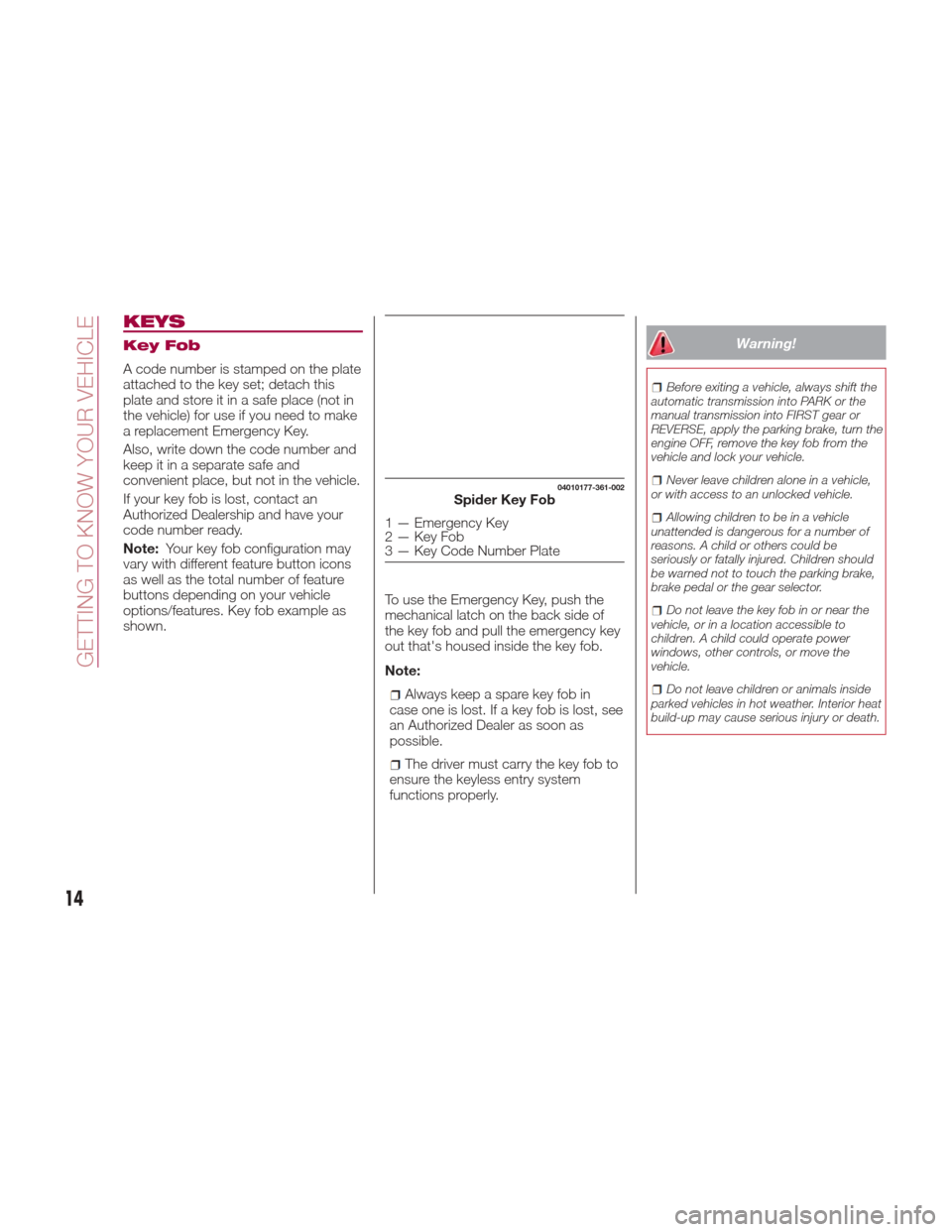
KEYS
Key Fob
A code number is stamped on the plate
attached to the key set; detach this
plate and store it in a safe place (not in
the vehicle) for use if you need to make
a replacement Emergency Key.
Also, write down the code number and
keep it in a separate safe and
convenient place, but not in the vehicle.
If your key fob is lost, contact an
Authorized Dealership and have your
code number ready.
Note:Your key fob configuration may
vary with different feature button icons
as well as the total number of feature
buttons depending on your vehicle
options/features. Key fob example as
shown. To use the Emergency Key, push the
mechanical latch on the back side of
the key fob and pull the emergency key
out that's housed inside the key fob.
Note:
Always keep a spare key fob in
case one is lost. If a key fob is lost, see
an Authorized Dealer as soon as
possible.
The driver must carry the key fob to
ensure the keyless entry system
functions properly.
Warning!
Before exiting a vehicle, always shift the
automatic transmission into PARK or the
manual transmission into FIRST gear or
REVERSE, apply the parking brake, turn the
engine OFF, remove the key fob from the
vehicle and lock your vehicle.
Never leave children alone in a vehicle,
or with access to an unlocked vehicle.
Allowing children to be in a vehicle
unattended is dangerous for a number of
reasons. A child or others could be
seriously or fatally injured. Children should
be warned not to touch the parking brake,
brake pedal or the gear selector.
Do not leave the key fob in or near the
vehicle, or in a location accessible to
children. A child could operate power
windows, other controls, or move the
vehicle.
Do not leave children or animals inside
parked vehicles in hot weather. Interior heat
build-up may cause serious injury or death.
04010177-361-002Spider Key Fob
1 — Emergency Key
2 — Key Fob
3 — Key Code Number Plate
14
GETTING TO KNOW YOUR VEHICLE
Page 23 of 300
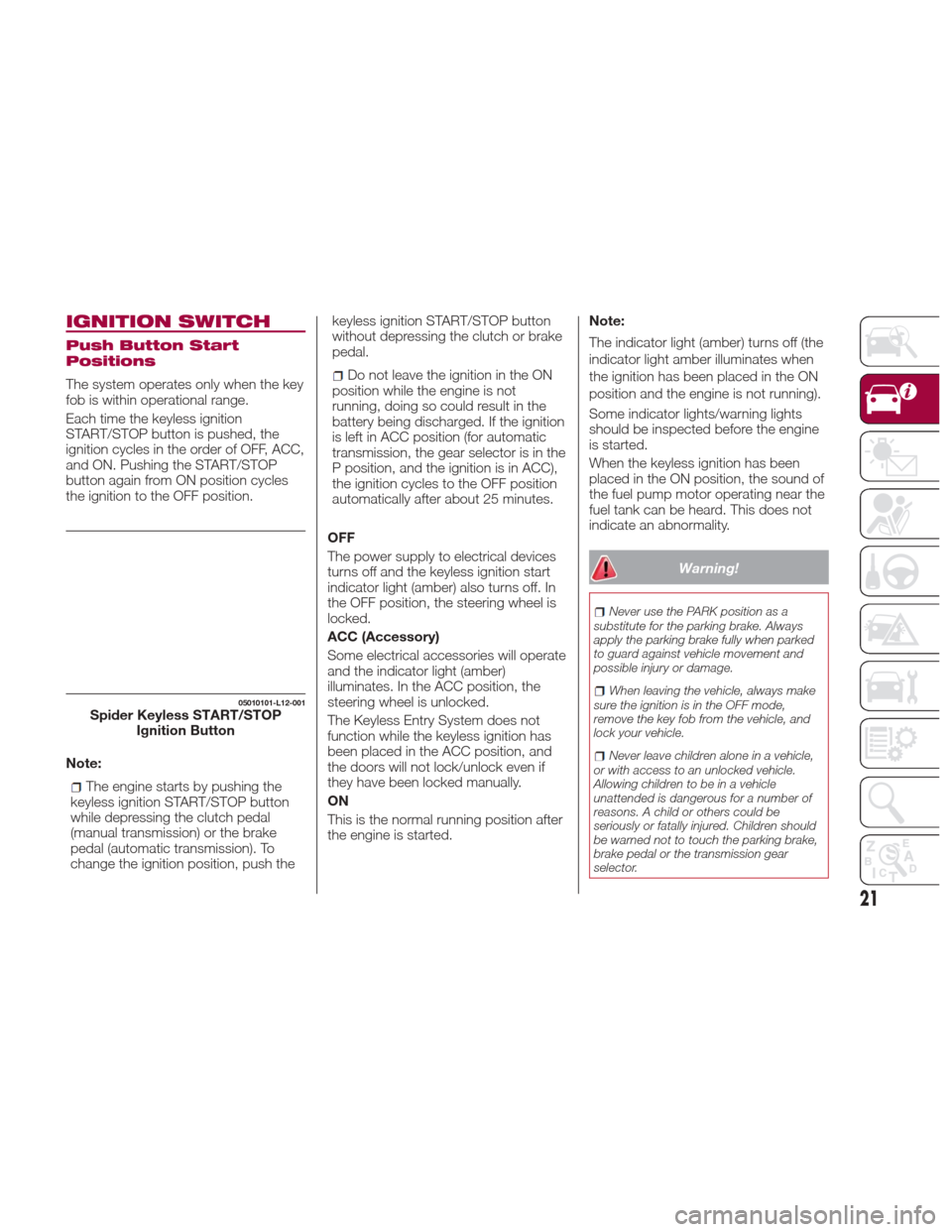
IGNITION SWITCH
Push Button Start
Positions
The system operates only when the key
fob is within operational range.
Each time the keyless ignition
START/STOP button is pushed, the
ignition cycles in the order of OFF, ACC,
and ON. Pushing the START/STOP
button again from ON position cycles
the ignition to the OFF position.
Note:
The engine starts by pushing the
keyless ignition START/STOP button
while depressing the clutch pedal
(manual transmission) or the brake
pedal (automatic transmission). To
change the ignition position, push the keyless ignition START/STOP button
without depressing the clutch or brake
pedal.
Do not leave the ignition in the ON
position while the engine is not
running, doing so could result in the
battery being discharged. If the ignition
is left in ACC position (for automatic
transmission, the gear selector is in the
P position, and the ignition is in ACC),
the ignition cycles to the OFF position
automatically after about 25 minutes.
OFF
The power supply to electrical devices
turns off and the keyless ignition start
indicator light (amber) also turns off. In
the OFF position, the steering wheel is
locked.
ACC (Accessory)
Some electrical accessories will operate
and the indicator light (amber)
illuminates. In the ACC position, the
steering wheel is unlocked.
The Keyless Entry System does not
function while the keyless ignition has
been placed in the ACC position, and
the doors will not lock/unlock even if
they have been locked manually.
ON
This is the normal running position after
the engine is started. Note:
The indicator light (amber) turns off (the
indicator light amber illuminates when
the ignition has been placed in the ON
position and the engine is not running).
Some indicator lights/warning lights
should be inspected before the engine
is started.
When the keyless ignition has been
placed in the ON position, the sound of
the fuel pump motor operating near the
fuel tank can be heard. This does not
indicate an abnormality.
Warning!
Never use the PARK position as a
substitute for the parking brake. Always
apply the parking brake fully when parked
to guard against vehicle movement and
possible injury or damage.
When leaving the vehicle, always make
sure the ignition is in the OFF mode,
remove the key fob from the vehicle, and
lock your vehicle.
Never leave children alone in a vehicle,
or with access to an unlocked vehicle.
Allowing children to be in a vehicle
unattended is dangerous for a number of
reasons. A child or others could be
seriously or fatally injured. Children should
be warned not to touch the parking brake,
brake pedal or the transmission gear
selector.
05010101-L12-001Spider Keyless START/STOP Ignition Button
21
Page 24 of 300
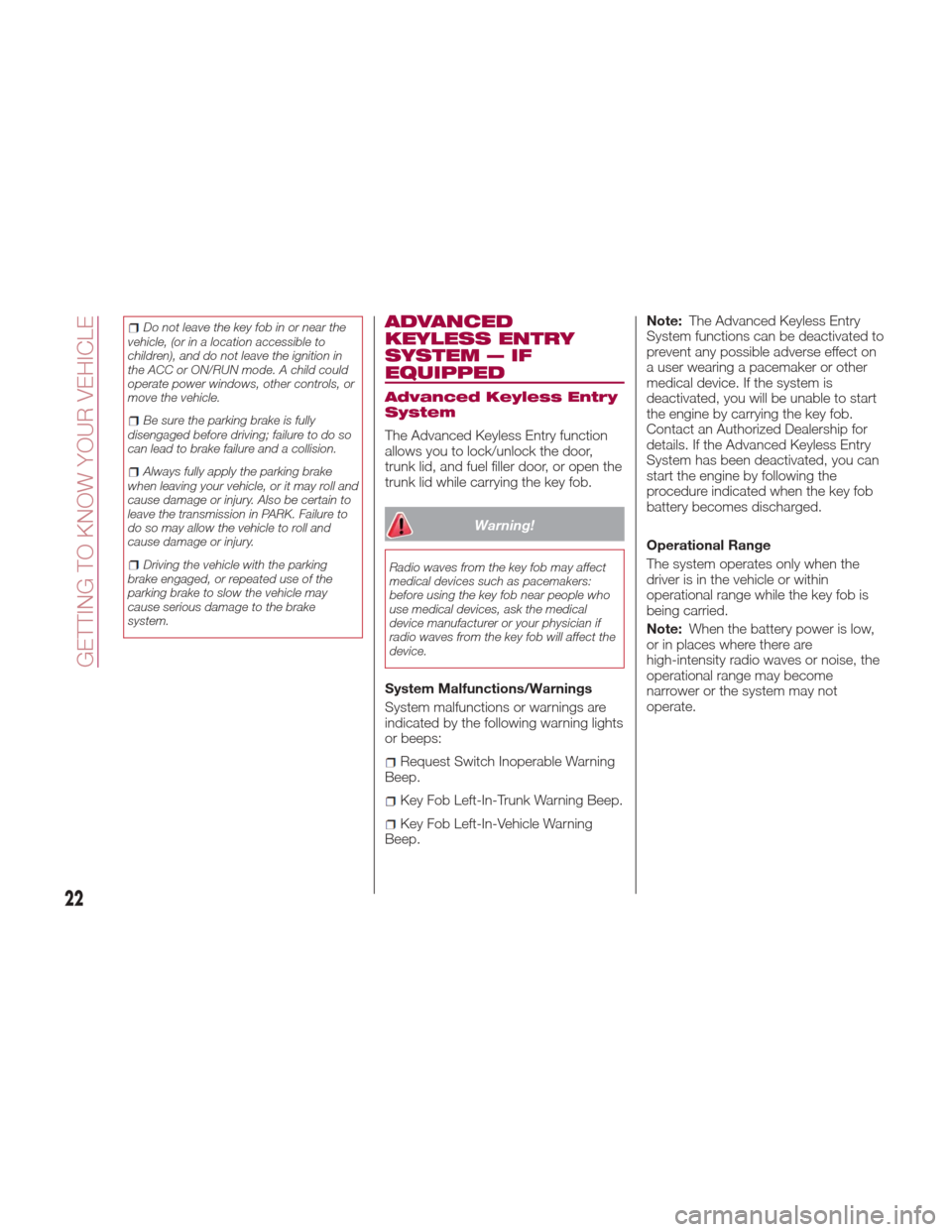
Do not leave the key fob in or near the
vehicle, (or in a location accessible to
children), and do not leave the ignition in
the ACC or ON/RUN mode. A child could
operate power windows, other controls, or
move the vehicle.
Be sure the parking brake is fully
disengaged before driving; failure to do so
can lead to brake failure and a collision.
Always fully apply the parking brake
when leaving your vehicle, or it may roll and
cause damage or injury. Also be certain to
leave the transmission in PARK. Failure to
do so may allow the vehicle to roll and
cause damage or injury.
Driving the vehicle with the parking
brake engaged, or repeated use of the
parking brake to slow the vehicle may
cause serious damage to the brake
system.
ADVANCED
KEYLESS ENTRY
SYSTEM — IF
EQUIPPED
Advanced Keyless Entry
System
The Advanced Keyless Entry function
allows you to lock/unlock the door,
trunk lid, and fuel filler door, or open the
trunk lid while carrying the key fob.
Warning!
Radio waves from the key fob may affect
medical devices such as pacemakers:
before using the key fob near people who
use medical devices, ask the medical
device manufacturer or your physician if
radio waves from the key fob will affect the
device.
System Malfunctions/Warnings
System malfunctions or warnings are
indicated by the following warning lights
or beeps:
Request Switch Inoperable Warning
Beep.
Key Fob Left-In-Trunk Warning Beep.
Key Fob Left-In-Vehicle Warning
Beep. Note:
The Advanced Keyless Entry
System functions can be deactivated to
prevent any possible adverse effect on
a user wearing a pacemaker or other
medical device. If the system is
deactivated, you will be unable to start
the engine by carrying the key fob.
Contact an Authorized Dealership for
details. If the Advanced Keyless Entry
System has been deactivated, you can
start the engine by following the
procedure indicated when the key fob
battery becomes discharged.
Operational Range
The system operates only when the
driver is in the vehicle or within
operational range while the key fob is
being carried.
Note: When the battery power is low,
or in places where there are
high-intensity radio waves or noise, the
operational range may become
narrower or the system may not
operate.
22
GETTING TO KNOW YOUR VEHICLE
Page 29 of 300
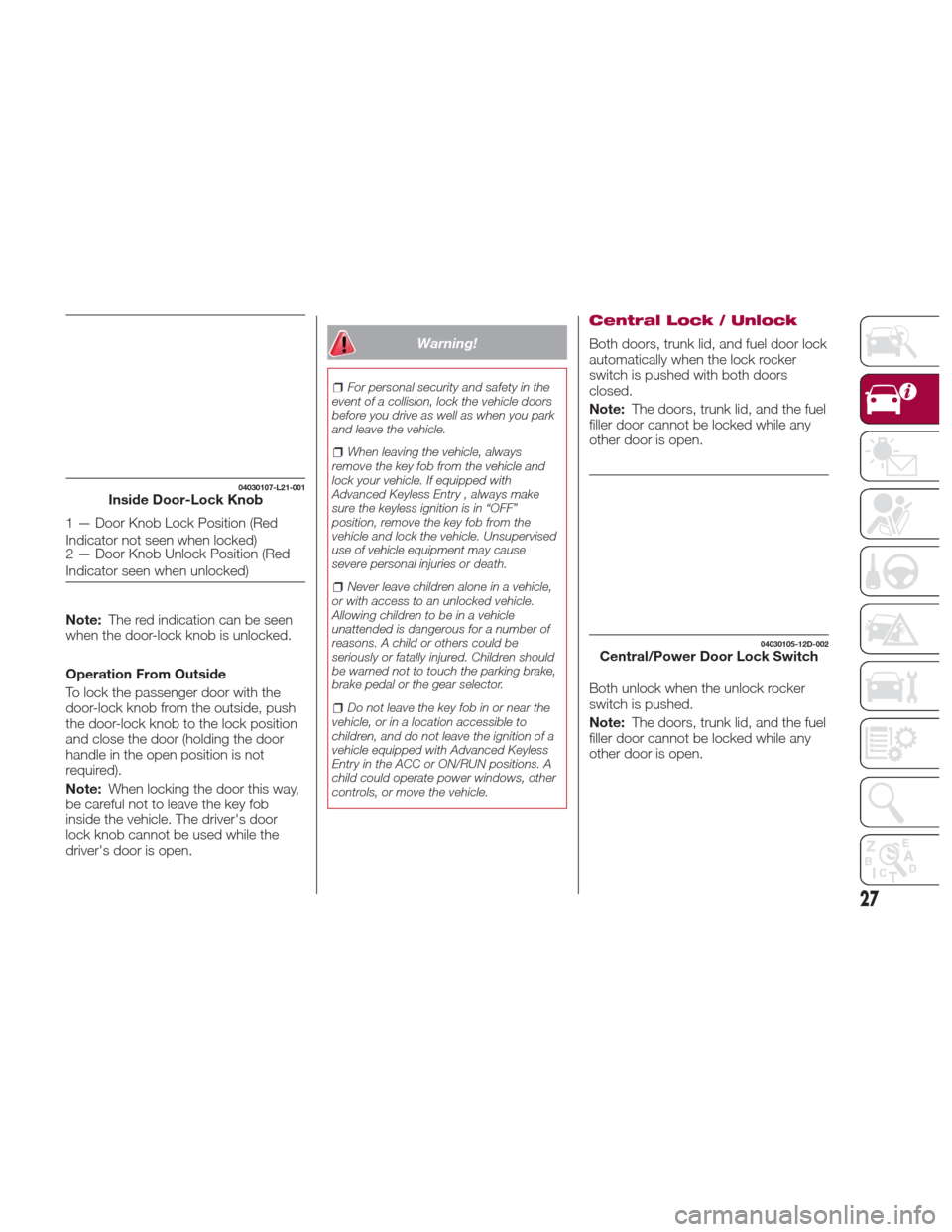
Note:The red indication can be seen
when the door-lock knob is unlocked.
Operation From Outside
To lock the passenger door with the
door-lock knob from the outside, push
the door-lock knob to the lock position
and close the door (holding the door
handle in the open position is not
required).
Note: When locking the door this way,
be careful not to leave the key fob
inside the vehicle. The driver's door
lock knob cannot be used while the
driver's door is open.
Warning!
For personal security and safety in the
event of a collision, lock the vehicle doors
before you drive as well as when you park
and leave the vehicle.
When leaving the vehicle, always
remove the key fob from the vehicle and
lock your vehicle. If equipped with
Advanced Keyless Entry , always make
sure the keyless ignition is in “OFF”
position, remove the key fob from the
vehicle and lock the vehicle. Unsupervised
use of vehicle equipment may cause
severe personal injuries or death.
Never leave children alone in a vehicle,
or with access to an unlocked vehicle.
Allowing children to be in a vehicle
unattended is dangerous for a number of
reasons. A child or others could be
seriously or fatally injured. Children should
be warned not to touch the parking brake,
brake pedal or the gear selector.
Do not leave the key fob in or near the
vehicle, or in a location accessible to
children, and do not leave the ignition of a
vehicle equipped with Advanced Keyless
Entry in the ACC or ON/RUN positions. A
child could operate power windows, other
controls, or move the vehicle.
Central Lock / Unlock
Both doors, trunk lid, and fuel door lock
automatically when the lock rocker
switch is pushed with both doors
closed.
Note: The doors, trunk lid, and the fuel
filler door cannot be locked while any
other door is open.
Both unlock when the unlock rocker
switch is pushed.
Note: The doors, trunk lid, and the fuel
filler door cannot be locked while any
other door is open.
04030107-L21-001Inside Door-Lock Knob
1 — Door Knob Lock Position (Red
Indicator not seen when locked)
2 — Door Knob Unlock Position (Red
Indicator seen when unlocked)
04030105-12D-002Central/Power Door Lock Switch
27
Page 60 of 300
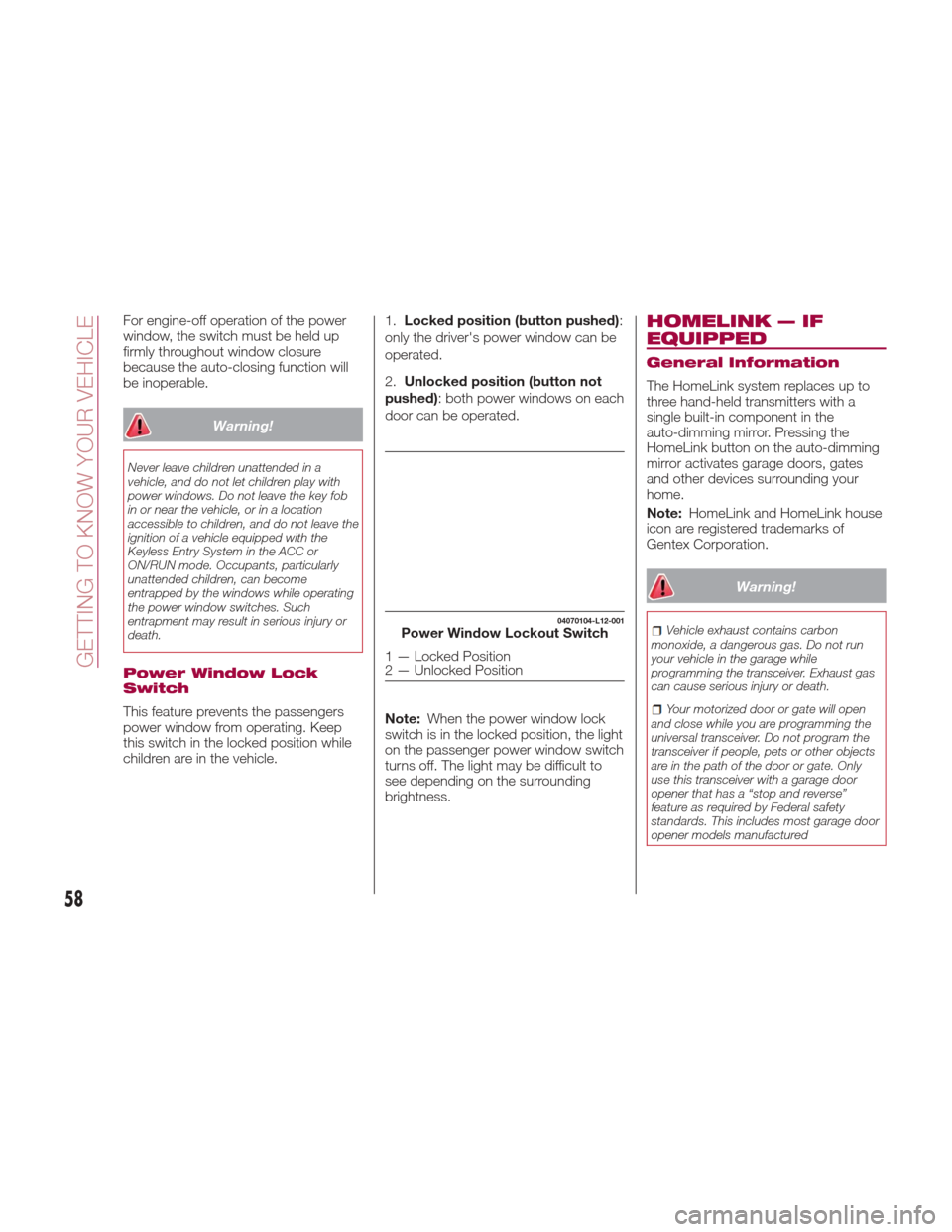
For engine-off operation of the power
window, the switch must be held up
firmly throughout window closure
because the auto-closing function will
be inoperable.
Warning!
Never leave children unattended in a
vehicle, and do not let children play with
power windows. Do not leave the key fob
in or near the vehicle, or in a location
accessible to children, and do not leave the
ignition of a vehicle equipped with the
Keyless Entry System in the ACC or
ON/RUN mode. Occupants, particularly
unattended children, can become
entrapped by the windows while operating
the power window switches. Such
entrapment may result in serious injury or
death.
Power Window Lock
Switch
This feature prevents the passengers
power window from operating. Keep
this switch in the locked position while
children are in the vehicle.1.
Locked position (button pushed) :
only the driver's power window can be
operated.
2. Unlocked position (button not
pushed): both power windows on each
door can be operated.
Note: When the power window lock
switch is in the locked position, the light
on the passenger power window switch
turns off. The light may be difficult to
see depending on the surrounding
brightness.
HOMELINK — IF
EQUIPPED
General Information
The HomeLink system replaces up to
three hand-held transmitters with a
single built-in component in the
auto-dimming mirror. Pressing the
HomeLink button on the auto-dimming
mirror activates garage doors, gates
and other devices surrounding your
home.
Note: HomeLink and HomeLink house
icon are registered trademarks of
Gentex Corporation.
Warning!
Vehicle exhaust contains carbon
monoxide, a dangerous gas. Do not run
your vehicle in the garage while
programming the transceiver. Exhaust gas
can cause serious injury or death.
Your motorized door or gate will open
and close while you are programming the
universal transceiver. Do not program the
transceiver if people, pets or other objects
are in the path of the door or gate. Only
use this transceiver with a garage door
opener that has a “stop and reverse”
feature as required by Federal safety
standards. This includes most garage door
opener models manufactured
04070104-L12-001Power Window Lockout Switch
1 — Locked Position
2 — Unlocked Position
58
GETTING TO KNOW YOUR VEHICLE
Page 70 of 300
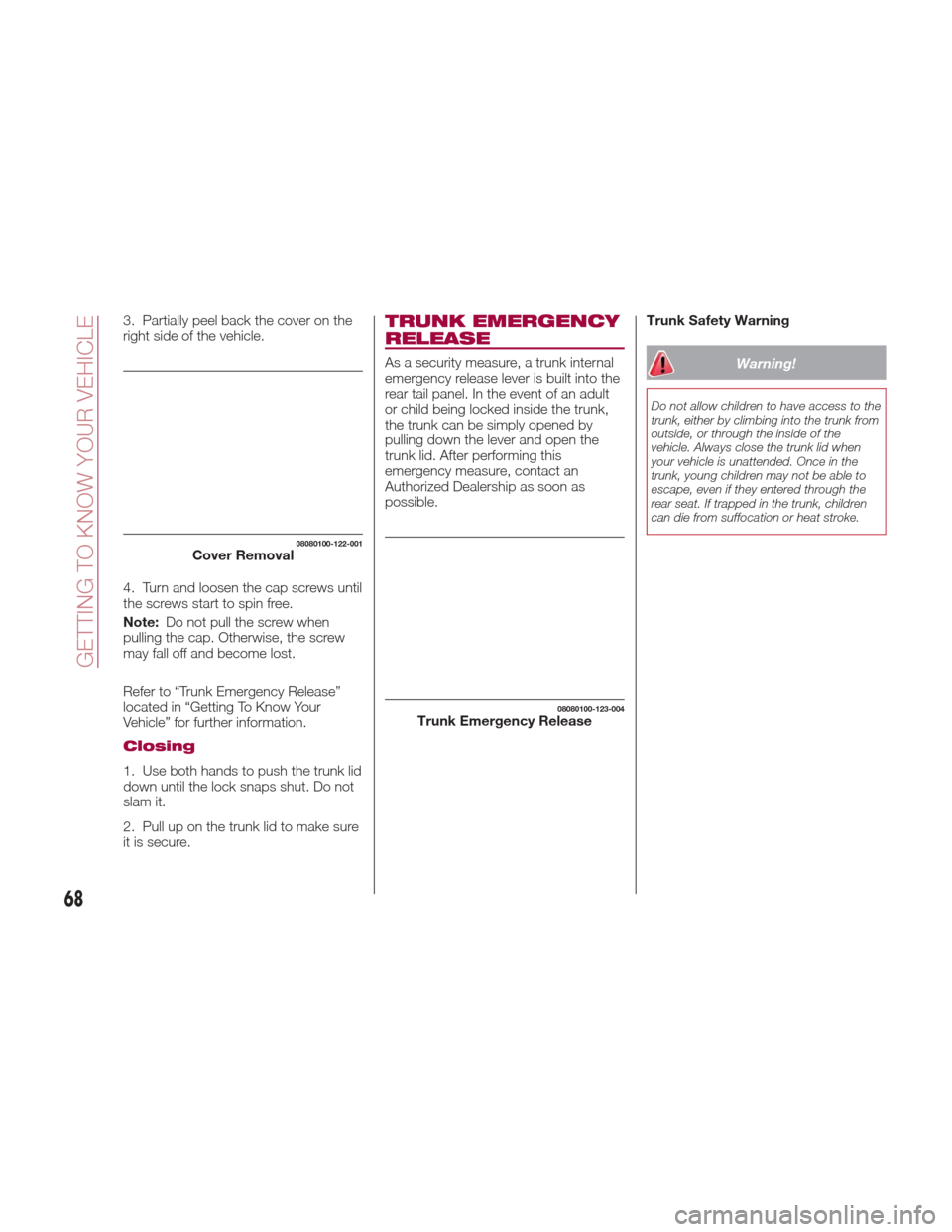
3. Partially peel back the cover on the
right side of the vehicle.
4. Turn and loosen the cap screws until
the screws start to spin free.
Note:Do not pull the screw when
pulling the cap. Otherwise, the screw
may fall off and become lost.
Refer to “Trunk Emergency Release”
located in “Getting To Know Your
Vehicle” for further information.
Closing
1. Use both hands to push the trunk lid
down until the lock snaps shut. Do not
slam it.
2. Pull up on the trunk lid to make sure
it is secure.
TRUNK EMERGENCY
RELEASE
As a security measure, a trunk internal
emergency release lever is built into the
rear tail panel. In the event of an adult
or child being locked inside the trunk,
the trunk can be simply opened by
pulling down the lever and open the
trunk lid. After performing this
emergency measure, contact an
Authorized Dealership as soon as
possible. Trunk Safety WarningWarning!
Do not allow children to have access to the
trunk, either by climbing into the trunk from
outside, or through the inside of the
vehicle. Always close the trunk lid when
your vehicle is unattended. Once in the
trunk, young children may not be able to
escape, even if they entered through the
rear seat. If trapped in the trunk, children
can die from suffocation or heat stroke.
08080100-122-001Cover Removal
08080100-123-004Trunk Emergency Release
68
GETTING TO KNOW YOUR VEHICLE
Page 108 of 300

passengers seat. The sensor may not
function properly because the
additional seat cushion could cause
sensor interference.
If a small child is seated on the
passengers seat, the warning beep
may not operate.
Mexico
If the vehicle speed exceeds about
12 MPH (20 km/h) with the driver or
passengers seat belt unfastened, a
warning beep sounds continuously. If
the seat belt remains unfastened, the
beep sound stops once and then
continues for about 90 seconds. The
beep stops after the driver or
passengers seat belt is fastened.
Until a seat belt is fastened or a given
period of time has elapsed, the beep
sound will not stop even if the vehicle
speed falls below 12 MPH (20 km/h).
Warning!
Placing heavy items on the front
passenger seat may cause the front
passenger seat belt warning function to
operate depending on the weight of the
item.
To allow the front passenger seat weight
sensor to function properly, do not place
and sit on an additional seat cushion on the
front passenger seat. The sensor may not
function properly because the additional
seat cushion could cause sensor
interference.
When a small child sits on the front
passenger seat, it is possible that the
warning beep will not operate.
Ignition Not Switched OFF
If the driver's door is opened while the
ignition is placed in the ACC position, a
continuous beep sound will be heard to
notify the driver that the ignition has not
been placed in the OFF position.
Left in this condition, the keyless entry
system will not operate, the car cannot
be locked, and the battery power will
be depleted.
Key Removed From Vehicle
Warning Beep
A beep sound will be heard 6 times
and the
warning light (red) will flash
continuously if the ignition has not been
placed in the OFF position, all the doors
are closed, and the key fob is removed
from the vehicle.
This is to notify the driver that the key
fob has been removed from the vehicle
and the ignition has not been placed in
the OFF position. Note:
Because the key fob uses
low-intensity radio waves, the
warning may activate if the key fob
is carried together with a metal object
or it is placed in a poor signal reception
area.
Request Switch Inoperable Warning
Beep — If Equipped With Advanced
Keyless Function
If the request switch on the exterior
door handle is pushed with a door
open, or the ignition has not been
placed in the OFF position, a beep will
be heard for about 2 seconds to
indicate that the doors, and trunk lid
cannot be locked.
Key Left-In-Trunk Compartment
Warning Beep — If Equipped With
Advanced Keyless Function
If the key fob is left in the trunk with all
doors locked and the trunk lid closed, a
beep sound is heard for about
10 seconds to remind the driver the key
fob has been left in the trunk.
If this happens, open the trunk lid by
pushing the electric trunk lid opener
and remove the key fob.
A key fob removed from the trunk may
not function because its functions may
have been temporarily suspended. To
restore the key fob function, perform
the applicable procedure (see
paragraph “Keys” in “Getting to know
your vehicle” chapter).
106
GETTING TO KNOW YOUR INSTRUMENT PANEL
Page 126 of 300
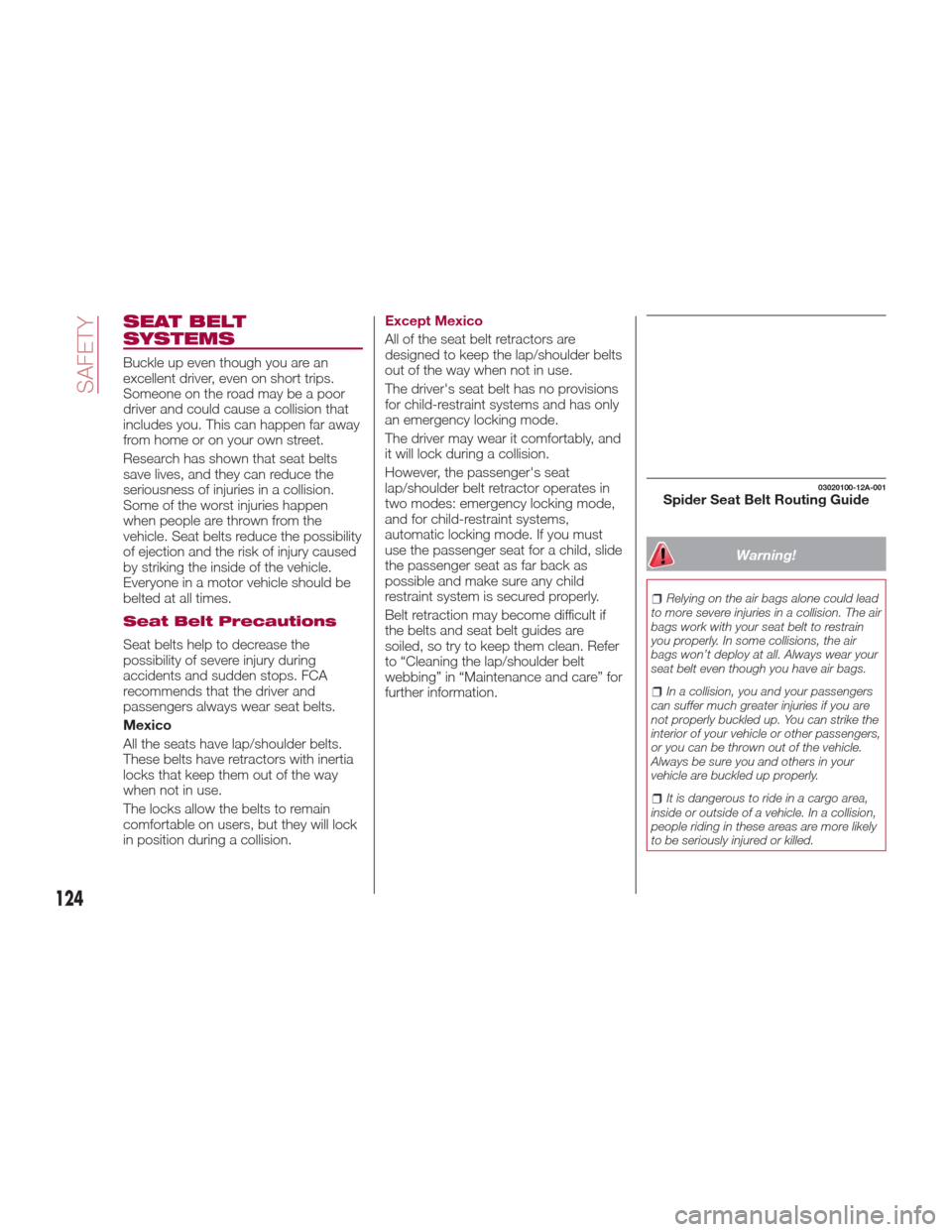
SEAT BELT
SYSTEMS
Buckle up even though you are an
excellent driver, even on short trips.
Someone on the road may be a poor
driver and could cause a collision that
includes you. This can happen far away
from home or on your own street.
Research has shown that seat belts
save lives, and they can reduce the
seriousness of injuries in a collision.
Some of the worst injuries happen
when people are thrown from the
vehicle. Seat belts reduce the possibility
of ejection and the risk of injury caused
by striking the inside of the vehicle.
Everyone in a motor vehicle should be
belted at all times.
Seat Belt Precautions
Seat belts help to decrease the
possibility of severe injury during
accidents and sudden stops. FCA
recommends that the driver and
passengers always wear seat belts.
Mexico
All the seats have lap/shoulder belts.
These belts have retractors with inertia
locks that keep them out of the way
when not in use.
The locks allow the belts to remain
comfortable on users, but they will lock
in position during a collision.Except Mexico
All of the seat belt retractors are
designed to keep the lap/shoulder belts
out of the way when not in use.
The driver's seat belt has no provisions
for child-restraint systems and has only
an emergency locking mode.
The driver may wear it comfortably, and
it will lock during a collision.
However, the passenger's seat
lap/shoulder belt retractor operates in
two modes: emergency locking mode,
and for child-restraint systems,
automatic locking mode. If you must
use the passenger seat for a child, slide
the passenger seat as far back as
possible and make sure any child
restraint system is secured properly.
Belt retraction may become difficult if
the belts and seat belt guides are
soiled, so try to keep them clean. Refer
to “Cleaning the lap/shoulder belt
webbing” in “Maintenance and care” for
further information.
Warning!
Relying on the air bags alone could lead
to more severe injuries in a collision. The air
bags work with your seat belt to restrain
you properly. In some collisions, the air
bags won’t deploy at all. Always wear your
seat belt even though you have air bags.
In a collision, you and your passengers
can suffer much greater injuries if you are
not properly buckled up. You can strike the
interior of your vehicle or other passengers,
or you can be thrown out of the vehicle.
Always be sure you and others in your
vehicle are buckled up properly.
It is dangerous to ride in a cargo area,
inside or outside of a vehicle. In a collision,
people riding in these areas are more likely
to be seriously injured or killed.
03020100-12A-001Spider Seat Belt Routing Guide
124
SAFETY